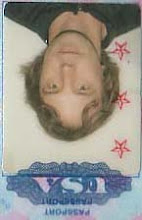Wednesday, March 08, 2006
After a few days of great (& much needed) respite in Thailand, where I spent a bit of time working on this week’s lecture, landed hard but firmly in the Cyberjaya saddle again this morning. It wasn’t hard to get back into the rountine/groove, which I like, but the work itself—scripting the media for the lecture—was quite difficult. The text is ready and solid, I only had to shuffle a couple of paragraphs, and add a bit once it became a fact that I would have Mac OS 9 to work with (which I do, thanks to Zie, the FCM tech guru). The hard part was to finalize exactly what pieces I would show as works representative of digital poetry, and then coordinate how they would be presented. It took all day to divine the information. Here’s what I’m working with:
Loss Pequeño Glazier’s “Io Sono At Swoons,” John Cayley’s “Essay on the Golden Lion,” Pedro Barbosa’s “Porto” (Alire 8), “Peter's Haiku Generator,””MERZ Poems 3.1,” mIEKAL aND’s “Seedsigns (for Philadelpho Menezes),” Komninos Zervos’ “Beer,” R2’s “Poesia Extática” (Revista Cortex 1 cd-rom), Augusto de Campos’ “SOS” & “sem-saida” (Não Poems cd-rom), Jim Andrews’, Arteroids 2.5, Aya Karpinska’s "The Arrival of the beeBox," Robert Kendall’s "Frame Work," Stephanie Strickland’s “The Ballad of Sand and Harry Soot,” Jim Rosenberg’s “Intergrams,” Maria Mencia’s, "Birds Singing Other Birds Songs," Ladislao Pablo Györi’s “Virtual Poems,” Cayley’s “riverIsland,” and Brian Kim Stefans’ "The Dreamlife of Letters." I’ll also be showing a few pages of Mallarmé’s “Un Coup de Des,” mentioning historical predecessors featured on Florian Cramer’s Permutations site, and showing images of works by Lionel Kearns, Marc Adrian, Carl Fernbach-Flarsheim, Leslie Mezei, Adele Aldridge, Lillian F. Schwartz and Ken Knowlton, David Daniels, Erthos Albino de Souza, Greta Monach, Clemente Padín, Andrews, Harry Polkinhorn, E.M. de Melo e Castro, Geof Huth, Philippe Bootz, Jean-Marie Dutey, André Vallias, Eduardo Kac, and Richard Kostelanetz. I’ve also created 3 slides that outline the typologies devised in Prehistoric Digital Poetry for text-generators, visual works, and hypertexts, so there will be plenty of visual stimuli for the audience.
A lot to cover in 90 minutes (approximately 10 years of research)!
Otherwise, tomorrow I have my first meeting with a database specialist at MMU, and have yet another lecture to prepare for Monday (luckily the focus is also on digital poetry). No problem finding tasks to keep me busy…
Loss Pequeño Glazier’s “Io Sono At Swoons,” John Cayley’s “Essay on the Golden Lion,” Pedro Barbosa’s “Porto” (Alire 8), “Peter's Haiku Generator,””MERZ Poems 3.1,” mIEKAL aND’s “Seedsigns (for Philadelpho Menezes),” Komninos Zervos’ “Beer,” R2’s “Poesia Extática” (Revista Cortex 1 cd-rom), Augusto de Campos’ “SOS” & “sem-saida” (Não Poems cd-rom), Jim Andrews’, Arteroids 2.5, Aya Karpinska’s "The Arrival of the beeBox," Robert Kendall’s "Frame Work," Stephanie Strickland’s “The Ballad of Sand and Harry Soot,” Jim Rosenberg’s “Intergrams,” Maria Mencia’s, "Birds Singing Other Birds Songs," Ladislao Pablo Györi’s “Virtual Poems,” Cayley’s “riverIsland,” and Brian Kim Stefans’ "The Dreamlife of Letters." I’ll also be showing a few pages of Mallarmé’s “Un Coup de Des,” mentioning historical predecessors featured on Florian Cramer’s Permutations site, and showing images of works by Lionel Kearns, Marc Adrian, Carl Fernbach-Flarsheim, Leslie Mezei, Adele Aldridge, Lillian F. Schwartz and Ken Knowlton, David Daniels, Erthos Albino de Souza, Greta Monach, Clemente Padín, Andrews, Harry Polkinhorn, E.M. de Melo e Castro, Geof Huth, Philippe Bootz, Jean-Marie Dutey, André Vallias, Eduardo Kac, and Richard Kostelanetz. I’ve also created 3 slides that outline the typologies devised in Prehistoric Digital Poetry for text-generators, visual works, and hypertexts, so there will be plenty of visual stimuli for the audience.
A lot to cover in 90 minutes (approximately 10 years of research)!
Otherwise, tomorrow I have my first meeting with a database specialist at MMU, and have yet another lecture to prepare for Monday (luckily the focus is also on digital poetry). No problem finding tasks to keep me busy…
